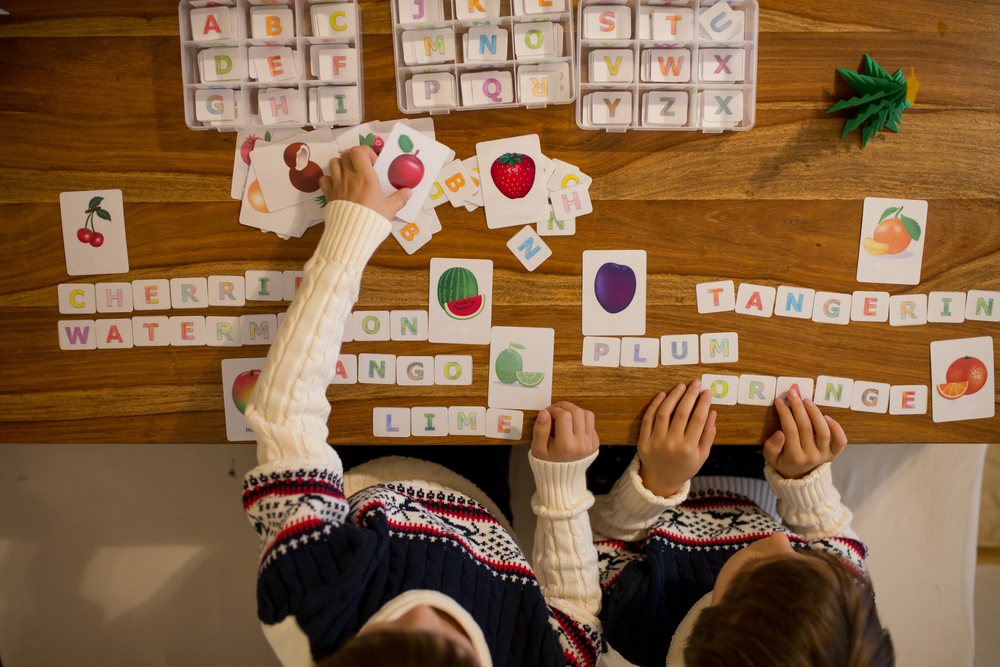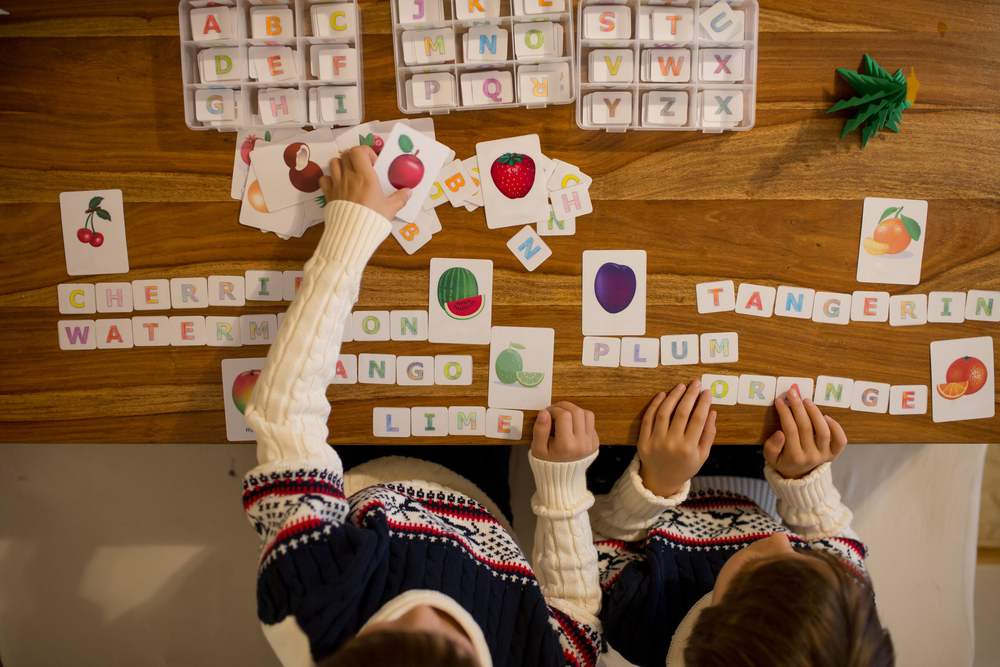Vocabulary can open up a world of communication (listening, speaking, reading, and writing) for children, and building a strong vocabulary can be fun and help kids learn about the world. The right vocabulary strategies can help.
If you’re wondering where to start, you’ve come to the right place! We’ve compiled a comprehensive list to help your child build a vocabulary that will support them throughout their lifelong learning journey.
Why Are Vocabulary Strategies Important?

Do you know that feeling you get when you finally find the right word to express yourself after struggling for some time? Amazing, isn’t it? That’s the power of words — they allow us to communicate our thoughts, feelings, and emotions.
Vocabulary lets you share ideas and define your thoughts with accuracy. Helping children develop a strong vocabulary allows them to express themselves.
In fact, between the ages of one and five children go through a vocabulary explosion. A one year old recognizes about 50 words; a five-year-old recognizes about 10,000! Of course, this varies by child, but you can see the importance of vocabulary.
Also, consider that children will come across lots of different books while in school. From literature to math, physics, history, and more, all of these books are explained to students in words they’ll need to understand if they are to grow and develop.
Reading comprehension is another important reason to help your child widen their vocabulary. Kids may struggle to interpret reading material when they find words they don’t fully understand.
These are just a few reasons why learning new words is so important for kids. But if you’re developing a vocabulary strategy for your child, where do you start? Let’s take a look!
Introducing New Words

When you think about vocabulary strategies, it can be tempting to focus on the number of words your child learns. But understanding the meaning behind the words is just as important, especially if you wish for your child to use them correctly.
Here are some important steps to follow when introducing new words.
1) Offer A Simple Explanation
When teaching your child a new word, focus on being concise and giving a simple explanation for the term.
2) Give Examples
One of the best ways to help anyone understand the meaning of a word is by giving examples of how the word can be used in a sentence.
If the word sounds or is spelled similarly to another word, giving examples will also help reduce confusion about the word’s meaning.
3) Use The Word
It may take a few times of hearing or seeing a new word for it to form part of your child’s long-term memory.
To help your child remember the word, try to use it regularly in plenty of relevant conversations until your child can form their own sentences with it.
4) Act It Out
Acting a word out can be an effective (and fun!) strategy for younger children, especially if they have lots of energy and love to move around.
The word balance, for example, can come alive through holding a tray of food without it falling or through trying to stand on one leg.
Now that you understand the value of a solid vocabulary and the process of introducing new words, let’s get into some tactics you can use at home.
6 Effective Vocabulary Strategies
1) Word Of The Day

By introducing a new word each day, you have the opportunity to highlight special words, funny words, and powerful words — like stupendous, famished, and flummoxed — to immerse your child in the wonderfulness of our language.
However, if introducing a new word each day feels a little overwhelming, that’s OK! You can also choose to ease into it by introducing just one new vocabulary word per week.
Whichever option you think is best, you can get the whole family involved here — different family members can rotate in sharing new words they may come across online, from books, in magazines, or even from the good old dictionary.
By involving the whole family, everyone gets to brush up on their vocabulary!
2) Create A Word Wall
Creating a word wall in your child’s bedroom or playroom is a fantastic way to help your child see new words regularly and increase the chances of it sinking into their memory. This makes it one of the most effective vocabulary strategies.
Together with your child, simply write a new word on paper and stick it onto the wall. Once you do, remember to keep focusing on helping your child understand the meaning of the word.
A simple way to achieve this is by asking them to describe the new word in their own way. If, from their explanation, they don’t seem to understand the word, you will know where the misunderstanding is and be able to rectify it quickly.
3) Read Aloud Together

It’s challenging (and maybe even impossible) to build a wide vocabulary without reading regularly. That’s why it’s an essential part of vocabulary strategies.
When choosing books, keep your child’s interests in mind and consider the topics they can relate to. Doing so will help encourage reading for enjoyment and build a love for reading.
When children are younger, it’s normal for parents to read aloud to them. But even when they can read independently, we still recommend regularly leading the reading process.
Children of all ages love hearing stories, and, more importantly, reading aloud to your child can help with books that they are not yet able to read alone. To make the most of your reading time, talk about what you’re reading and emphasize any unfamiliar words.
4) Learn Through Storytelling And Pretend Play

Your child can have the opportunity to use many of the new vocabulary words while storytelling through fun activities, like pretend play.
Pretend play is sometimes called make-believe or dramatic play. This is when kids pretend to be farmers, mail delivery people, teachers, veterinarians, or even mommy or daddy.
If you have multiple children, this is a fun way for them to exercise their imaginations, communication, and growing vocabulary.
To get started, you can use Homer’s Mail Adventure Kit. This kit encourages authentic writing by helping your child or children recreate their own post office. It includes envelopes, post office stickers, a cotton canvas bag, and more to help bring everything to life.
5) Continue Conversing
Everyday conversations are a great way to expose your child to lots of new words.
You don’t have to be doing anything extraordinary — you could be heading out to run an errand, taking the dog for a walk, cooking, or doing the laundry. There’s always a learning opportunity!
During these moments, remember to speak to your child about what you’re doing and why you’re doing it. Try to use as many descriptive words as possible. For example, after tasting a cookie, you can use words such as delicious or scrumptious instead of just saying, “It’s good.”
Conversing is one of the most effective vocabulary strategies because children are great sponges, so these little interactions can have a big impact.
6) Play Word Games

Why not add some fun to the learning mix with word games that help develop your child’s vocabulary?
A great game you can play with your child is substituting words with their synonyms. This game is fun for the whole family.
To get started, choose a common word and see how many synonyms or near-synonyms you can come up with. For example, synonyms for talk include: speak, converse, yell, shout, and so on. For walk, you could say stroll or meander.
You can also place a sheet of paper on the wall, and every time someone comes up with a new term, add it to the sheet. Can you get to ten synonyms of one word?
Vocabulary Strategies As Simple As ABC

As you can see from the activities above, there are many different ways to improve your child’s vocabulary.
Regularly introducing new words, creating a word wall, and reading aloud are all effective vocabulary strategies.
Writing, word games, and storytelling activities can also help kids practice all the new words they’ve learned. Lastly, making conversations a priority helps children link their new vocabulary words to real-life situations.
Whether you choose to use each strategy or rotate a few, remember to be consistent, patient, and positive. This can help your child build the confidence they need to face any new word with a good attitude.
Language development is essential for children’s success in school and beyond. As you continue introducing new words to your child, our Learn & Grow app is the perfect resource to help accompany your child’s growth and development and foster a lifelong love for learning!
,


